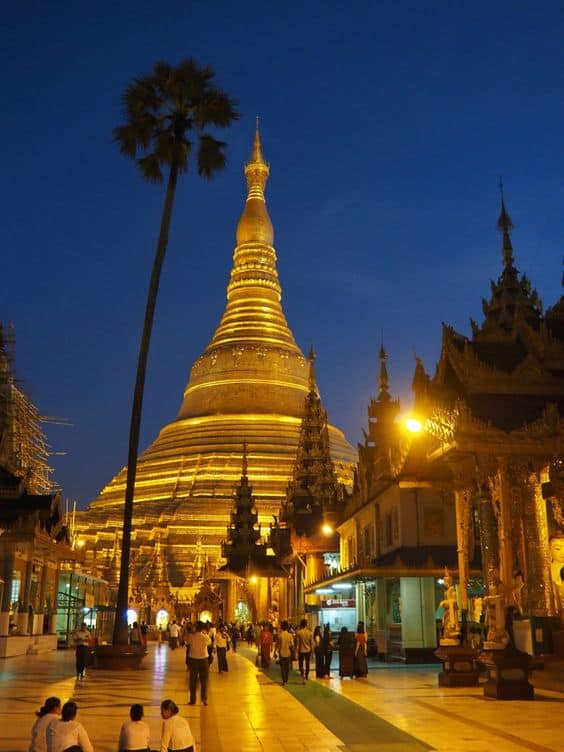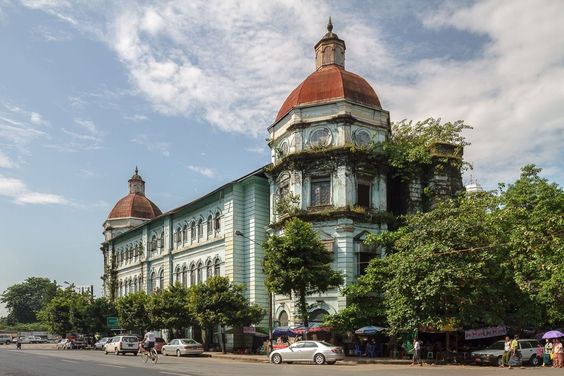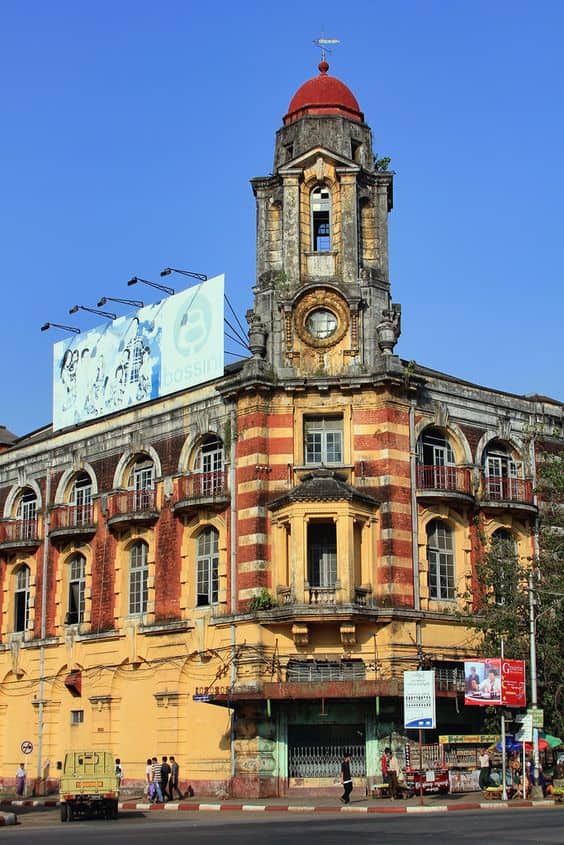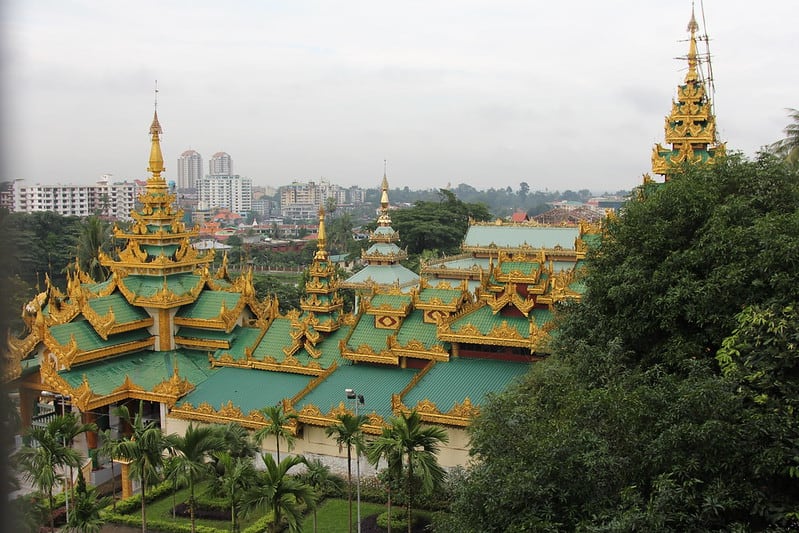History of Yangon/Rangoon
Yangon, the vibrant and bustling city of Myanmar (formerly known as Burma), has a rich and captivating history that stretches back centuries. From its humble beginnings as a small fishing village to its pivotal role as the capital city during the colonial era, Yangon has witnessed the ebb and flow of empires, the struggles for independence, and the transformation into a modern metropolis. Join us on a journey through time as we explore the captivating history of Yangon and the broader context of pre-independence Burma.
Early Settlement and Foundation: The story of Yangon dates back to the ancient Mon people, who were among the earliest inhabitants of the region. The area, then known as Dagon, was a small fishing village situated along the banks of the Yangon River. Legend has it that the village was founded by the Mon king, Okkalapa, in the 6th century AD.
Mon and Bamar Dynasties: Over the centuries, Yangon changed hands multiple times between the Mon and Bamar kingdoms. The Mon people, known for their seafaring prowess and artistic culture, left a significant influence on the region. However, in the 18th century, the Bamar King Alaungpaya conquered Yangon and incorporated it into the expanding Konbaung Dynasty.
Colonial Era and Rangoon as the Capital: The course of Yangon’s history took a dramatic turn in the 19th century when the British Empire, expanding its dominion in Southeast Asia, seized control of lower Burma. After the First Anglo-Burmese War in 1824, the British established Rangoon as the administrative capital of British Burma. Under British rule, Rangoon underwent rapid urbanization and modernisation, with the construction of infrastructure, such as railways, roads, and iconic colonial buildings.
Commercial Hub and Cultural Melting Pot: Rangoon thrived as a bustling commercial centre during the colonial era. Its strategic location, proximity to the Indian subcontinent, and access to natural resources made it a vital port city for trade. The city attracted a diverse mix of communities, including Indians, Chinese, Armenians, and Europeans, resulting in a vibrant cultural melting pot. This cultural diversity is still evident in Yangon today, with its diverse cuisine, religious landmarks, and architectural styles.
The Struggle for Independence: The 20th century witnessed a growing desire for independence from British rule in Burma. Yangon became a hotbed of political activities, with nationalist leaders emerging to rally the people. One of the most prominent figures was General Aung San, who played a pivotal role in the struggle for independence. After years of political negotiations, Burma finally gained independence on January 4, 1948, and Rangoon became the capital of the newly formed Union of Burma.
Post-Independence Challenges and Transition to Yangon: Following independence, Burma faced numerous challenges, including political instability, economic struggles, and ethnic tensions. In 1989, the military junta changed the country’s official English name from Burma to Myanmar, and the capital was moved to Naypyidaw in 2005. Rangoon was also officially renamed Yangon, reflecting the linguistic preferences of the majority Bamar population.
Modern Yangon: Today, Yangon continues to be the economic and cultural hub of Myanmar. The city is home to iconic landmarks such as the Shwedagon Pagoda, a magnificent Buddhist temple complex that stands as a symbol of Yangon’s spiritual and architectural heritage. The colonial buildings, bustling streets, and vibrant markets add to the city’s charm, attracting tourists from around the world.
In recent years, Yangon has experienced rapid development and modernisation. High-rise buildings, shopping malls, and international hotels have emerged, transforming the city’s skyline. However, amidst the modernisation efforts, Yangon still retains its traditional charm with quaint neighborhoods, street food stalls, and traditional teahouses that offer a glimpse into the city’s rich cultural fabric.
Preservation and Restoration: Efforts have been made to preserve and restore Yangon’s architectural heritage. Many of the colonial-era buildings, such as the Yangon City Hall, the Secretariat Building, and the Strand Hotel, have undergone restoration to maintain their historical significance. These structures serve as a reminder of Yangon’s colonial past and contribute to its unique character.
The history of Yangon (Rangoon) is intertwined with the broader narrative of pre-independence Burma. From its humble beginnings as a fishing village to its role as a colonial capital and now as a thriving metropolis, Yangon has evolved into a vibrant and dynamic city. Its rich history, cultural diversity, and architectural treasures make it a fascinating destination for both locals and visitors alike. As Yangon embraces the opportunities and challenges of the future, it continues to evolve while holding onto its unique identity and heritage.
Shwedagon Pagoda
Visit the Shwedagon Pagoda, also known as the Great Dragon Pagoda and Golden Pagoda, in Yangon, Myanmar. This ancient stupa is located in the heart of the city and is a must-see for visitors to Myanmar. Its size and majesty make it an amazing site for a spiritual trip.
It is essential to dress appropriately for the visit. Women should wear loose, knee-length clothing and men should wear pants. Sarongs can be rented for men at the entrance. Visitors must also remove their shoes and socks to enter the pagoda, so it is advisable to wear comfortable shoes. Bringing a small bag to store your shoes and wet wipes is also recommended.
The Shwedagon Pagoda has numerous Buddha statues and several stupas. The central stupa is believed to contain the relics of the Buddha. There are also many shrines, temples, and other buildings in the complex.
Yangon Circular Train
The Yangon Circular Train connects the suburbs and satellite towns of Yangon. It is a 45.9-kilometer loop system that connects the city to the suburbs and satellite towns. The service is free and operates 24 hours a day. It is the most convenient way to get around Yangon.
The train leaves from the central railway station in Yangon. It is a 5-minute walk from Bogyoke Aung San Market. There are English-speaking staff at the station. It is recommended to get to the train station early in order to get a good seat. The train stops at various locations along the way.
The train is clean and comfortable, although there are no toilets. Carry a bottle of water for your journey, or buy bottled water at the next station. The train’s lounge has power banks, so you can charge your cellphone.

Botahtaung Pagoda
One of the things to do in Yangon is to visit the famous Botahtaung Pagodha, which is one of the oldest and largest pagodas in the country. Located on the highest hill in Yangon, it is adorned with gold plating and 7000 gems. It is considered one of the holiest Buddhist sites in Myanmar.
The name of this Buddhist temple is derived from a legend of Buddha’s hair being brought to Myanmar more than two thousand years ago. The relics of eight hairs from Buddha were brought to Yangon, and the 1,000 military leaders formed a guard of honor for them. These relics were later dispersed and enshrined in other pagodas. Now, only one of the original hairs remains at the Botataung Pagoda.
The Botataung Pagoda, also called Botahtaung, is a 40-meter tall structure in downtown Yangon. The structure was built by the Mon people around 2,500 years ago. It was partially destroyed during the second world war, but rebuilding began in 1948.
U Thant House
U Thant House in Yangon is a museum that houses U Thant’s former residence. This museum is operated by a nonprofit organization, the U Thant House Trust. The museum is open daily, except for Mondays, when it is closed. The museum is open for tours from 10 a.m. to 5 p.m.
The U Thant House in Yangon is a museum that preserves the life and legacy of the third Secretary General of the United Nations and the first Asian to take the honorary post. U Thant was a pioneer in many fields, including human rights, global poverty, and decolonization. He is also considered to be one of the most important educators in Myanmar. The house is now used as a museum and as a venue for public events.
Thant was born in Pantanaw and educated at the National High School and Rangoon University. He was known for his moderate political views and was a close friend of Burma’s first Prime Minister, U Nu. He served in various cabinet positions from 1948 to 1961, and his calm demeanor gained him much respect.
Taukkyan War Cemetery
The Taukkyan War Cemetery in Yangon is a cemetery that is located outside of the city. It is near the airport and adjacent to the village of Taukkyan. It can be reached via taxi, but public transit is also available. Public buses going to Bago pass by the cemetery. The cemetery contains 5559 grave markers.
Visitors can visit the cemetery during the day, and it is very peaceful and serene. It is open to the public from early morning until early evening. Visitors will find it particularly peaceful in the early morning. On Remembrance Day, the cemetery is decorated with flowers. The Commonwealth War Graves Commission maintains a database of the graves in this cemetery. It is estimated that over 5,000 Commonwealth forces soldiers are buried here.
The Taukkyan War Cemetery is located 20 miles north of Rangoon. It contains individual memorials to approximately 6,400 men who died for freedom. The cemetery contains graves that were exhumed from the jungle.

The Secretariat
One of the things to do in Yangon is to visit the Secretariat building. This 37,000 square meter building was once off limits, but recently opened to the public. The building is being renovated to create a cultural and art complex. Asia Tours Myanmar offers exclusive tours of the building.
The Secretariat is a historic building with a rich history. It was closed to the public until 1962 and photography was not allowed until a few years ago. The complex is described as an architectural treasure by the Yangon Heritage Trust. It has survived many wars and natural disasters, including a series of earthquakes. Cyclone Nargis, which killed 140,000 people in 2008, also left its mark.
The Secretariat is home to a variety of cultural and artistic spaces. Visitors can enjoy a traditional Yangon snack in the lobby every afternoon. The staff can also help plan your day and book activities, and teach you a few Burmese phrases.
National Museum
The National Museum is a must-see while visiting Yangon. It features royal regalia, ancient jewelry, and the traditional costumes of various ethnic groups of Myanmar. The museum is open daily from 10 am to 4 pm. It is located at the corner of Hanthawady Road and Kyun Taw Road. The museum is easily accessible by taxi or foot.
The National Museum in Yangon was first opened in 1952. The building has 14 halls displaying ancient artifacts and works of art. The exhibits are well lit, with signs in both English and Myanmar languages. The building is air-conditioned and attractive, and the museum staff are happy to welcome tourists.
The museum also has displays of Myanmar literature, art, and culture. It also features antique artifacts, manuscripts, and inscriptions. The museum is located a few kilometers from downtown Yangon. Many of the tours in Myanmar include a visit to the museum.

Chaukhtatgyi Buddha
The Chaukhtatgyi Buddha Temple is one of the most important Buddhist temples in Yangon and the Yangon Region. It is the home of one of the country’s most revered reclining Buddha images. The image is 66 metres long and one of the largest in Burma.
It is located near the Bahan Township in Yangon. The Buddha is seated in an open-sided steel and corrugated iron structure that is surrounded by many small temples. From the viewing platform, visitors can view the intricate detailing on the feet of the Buddha statue. The Buddha’s feet have 108 segments – a sacred number for Buddhists in Myanmar.
One of the most beautiful features of the Chaukhtatgyi Buddha Temple is its huge reclining Buddha. The statue was originally constructed in 1899 by a wealthy Burmese man named Sir Po Tha. In the mid-20th century, it underwent restorations to give it its current glory.
Best Places to Stay in Yangon
Nestled along the banks of the serene Yangon River, Myanmar’s former capital city, Yangon, beckons travelers with its enchanting mix of ancient temples, colonial architecture, and vibrant markets. As you embark on a journey to this cultural hub, selecting the perfect place to stay is key to embracing the city’s charm and hospitality. From luxurious hotels with panoramic city views to boutique hideaways oozing with local character, Yangon offers a delightful array of accommodations. Here’s a guide to some of the best places to stay in Yangon for an unforgettable experience.
1. The Strand Yangon: A Timeless Colonial Oasis
A true icon of Yangon’s colonial heritage, The Strand Yangon is a luxurious haven that exudes timeless elegance. Dating back to 1901, this historic hotel has hosted dignitaries, authors, and royalty, enveloping guests in an atmosphere of refined sophistication. The Strand’s opulent suites, furnished with fine antiques, offer a glimpse into a bygone era. Indulge in impeccable service, gourmet dining, and afternoon tea in the elegant Strand Café, as you bask in the allure of old-world charm.
2. Belmond Governor’s Residence: Serenity amidst Lush Gardens
Hidden away in a leafy residential area, Belmond Governor’s Residence is an oasis of tranquility and charm. Set within stunning gardens, this colonial-style boutique hotel offers spacious rooms and suites adorned with traditional Burmese art and antiques. Unwind in the peaceful surroundings of the poolside or pamper yourself with a spa treatment inspired by Myanmar’s ancient healing traditions. The Belmond Governor’s Residence is a sanctuary that epitomizes luxurious serenity.
3. Chatrium Hotel Royal Lake Yangon: Panoramic Views of the Shwedagon Pagoda
Situated on the shores of the tranquil Kandawgyi Lake, Chatrium Hotel Royal Lake Yangon boasts sweeping views of the iconic Shwedagon Pagoda. This elegant five-star hotel offers modern and well-appointed rooms and suites, with the Royal Lake Suite boasting private terraces and plunge pools. Enjoy the hotel’s recreational facilities, including a stunning outdoor pool, fitness center, and spa, all while being a stone’s throw away from Yangon’s cultural attractions.
4. Savoy Hotel Yangon: Colonial Charms with a Local Touch
Experience a seamless blend of colonial charm and Burmese hospitality at Savoy Hotel Yangon. This boutique heritage hotel preserves the essence of Yangon’s past with its colonial architecture and antique furnishings. The hotel’s intimate setting and personalized service create a welcoming atmosphere for guests. Relax in the lush garden oasis or savor authentic Myanmar cuisine at the Kipling’s Restaurant, named after the famous author who once stayed here.
5. Rose Garden Hotel Yangon: Contemporary Luxury in the Heart of the City
With its contemporary design and top-notch facilities, Rose Garden Hotel Yangon offers a modern retreat in the heart of the city. The spacious rooms and suites provide a comfortable stay, while the hotel’s rooftop pool and bar offer a chic setting to unwind and enjoy city vistas. Explore the nearby sights and return to the hotel’s serene ambiance, making it an ideal choice for both business and leisure travelers.
10 Interesting facts about Yangon
- Yangon is the cultural and economic center of Myanmar, and is home to over five million people.
- The city is located on the Yangon River, and is known for its beautiful colonial-era architecture, as well as the Shwedagon Pagoda, which is one of the most sacred Buddhist sites in the world.
- Yangon was the capital of British Burma from the mid-19th century until the country gained independence in 1948.
- The city has a tropical monsoon climate, with hot and humid summers and mild winters.
- Yangon is home to the National Museum of Myanmar, which houses an extensive collection of artifacts and artworks from the country’s history.
- The city is also home to the University of Yangon, which is one of the oldest and most prestigious universities in the country.
- Yangon is the hub of Myanmar’s transportation network, and is served by a large international airport, as well as a major port on the Bay of Bengal.
- The city is known for its vibrant street food scene, and is home to a number of popular markets, including the Bogyoke Aung San Market and the Scott Market.
- Yangon is also home to a number of large parks and green spaces, including Inya Lake, Kandawgyi Lake, and the Hlawga National Park.
- Despite its rapid growth and development, Yangon has managed to retain its traditional charm and character, and is a popular destination for travelers interested in exploring the rich culture and history of Myanmar.

